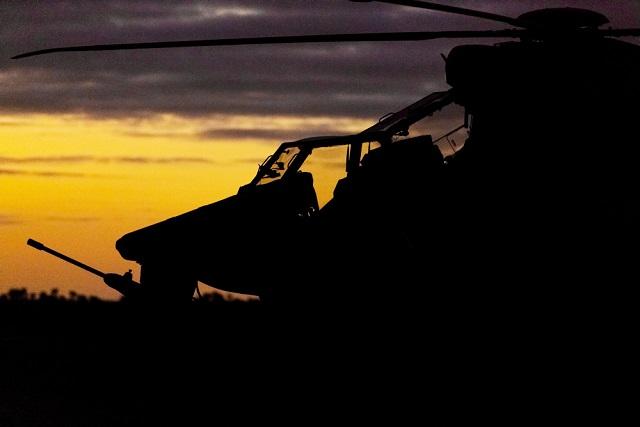The auditors get their teeth into the Tiger
Posted By Andrew Davies on September 2, 2016 @ 12:48

There are plenty of ‘headline issues’ in the Australian national Audit Office’s new report on the Tiger Armed Reconnaissance helicopter [1]. That’s not surprising, given that the government effectively gave up on the aircraft [2] as a long term prospect in the Defence White Paper earlier this year, announcing that it would be replaced rather than upgraded in the 2020s.
On the face of it, the performance figures cited by the ANAO suggest that the Tiger was a poor choice. Even after a protracted development program that led to final operational capability being a full seven years late, there’s still a litany of issues:
- As at April 2016, the Tiger also had 76 capability deficiencies relating to Army’s current and future operational requirements, 60 of which were deemed by Defence to be critical. Other key limitations relate to shipborne operations, pilot flying hours, interoperability and communications, airworthiness, and the roof-mounted sight.
- To date, sustainment costs have exceeded the original contract value. The 15 year (2004–2019) sustainment contract provided for expenditure of $571 million. That sum was expended by June 2014, and expenditure as at June 2016 was $921 million.
- As at June 2016, the cost per flying hour for the Tiger fleet was $30,335, compared to a target of $20,000. The long-term average was $39,472 per hour. Defence negotiated a cost cap to control sustainment cost growth in 2014.
- On average only 3.5 aircraft of the operational fleet (16 aircraft) were serviceable at 10AM on any given day in 2015, against a target of 12 aircraft.
But I don’t think it would be right to conclude that the aircraft is a dud. After all, other Tiger users have deployed their aircraft on operations. French, German and Spanish aircraft have all operated in Afghanistan, collectively logging over 3,000 hours in combat operations. So it’s worth understanding what went wrong here.
Let’s start with the most fundamental issue of all. It’s abundantly clear that the initial advice to government from Defence regarding the Tiger as a low risk ‘off-the-shelf’ acquisition was wrong, when in fact there was a considerable amount of development risk remaining. That erroneous assumption would inevitably lead to cost and schedule problems. As is often the case, it was the schedule that proved more problematic, blowing out by over 100%, while acquisition cost overruns came in at just 16%.
That error was then compounded by the fact that the initial estimates for the aircraft’s sustainment cost were badly underestimated. The planned acquisition cost of the 22 aircraft was $1.6 billion, compared to the $571 million for 15 years of support. There’s an immediate red flag. When we did through-life costings for aircraft for our pre-2009 White Paper force structuring exercise [3], we found that supporting aircraft fleets over 20 years typically cost between 1.3 and 2.1 times the acquisition cost. Helicopters were at the higher end of the price range (2.2 for naval combat helicopters and 1.9 for the Army’s Chinooks).
There’s no escaping the relationship between acquisition and through-life support costs, as they’re both driven by the complexity of the aircraft. Based on our data, we’d expect fleet support over 15 years to at least match the acquisition cost—maybe a little less due to lower rates of effort in the early years. The contract figure of 36% of the expected acquisition price was manifestly inadequate. Not surprisingly, the actual figure as of June this year was 58% ($635 million in2001 prices), even given woeful availability leading to flying hours well short of expectations. This looks similar to the Collins class submarine story prior to the Coles review [4]; woefully inadequate provision for support of a complex platform, which in turn leads to low rates of availability. In each case the net result was significant cost to the taxpayer for little ADF capability.
The ANAO says that Defence describe the support contract negotiations as ‘rushed’. That may be, but even a gross error check should identify an obviously over-optimistic assumption. If there’s any silver lining to be found in this aspect of the Tiger project, it’s that having to manage on inadequate resources has made for a very lean sustainment operation. Defence’s response to the auditor’s findings notes that the European users hold Australia’s cost controls in high regard. Hooray.
The other major issue with Australia’s acquisition of the Tiger is the indigenous configuration of the Army’s C4ISR network, which is not configured to work with the Tiger’s Eurogrid digital datalink. You can read more about that (and Army’s wider issues) in our recent ADF C4ISR review [5].
Finally, we’re not yet done with expenditure. I’ll let ANAO take us out:
‘The 2016 Defence White Paper allocated $500–$750 million to address the current capability requirements of the Tiger platform with a view to replacing the platform mid next decade, at a cost of some $5–$6 billion. In effect, an upgrade is scheduled for consideration less than 12 months after the Tiger achieved Final Operational Capability. Defence should conduct a thorough analysis of the value-for-money of investing further in the Tiger, pending the introduction of a replacement capability.’
Article printed from The Strategist: https://aspistrategist.ru
URL to article: /auditors-get-teeth-tiger/
URLs in this post:
[1] new report on the Tiger Armed Reconnaissance helicopter: https://www.anao.gov.au/work/performance-audit/tiger-armys-armed-reconnaissance-helicopter
[2] effectively gave up on the aircraft: https://aspistrategist.ru/tiger-tiger-not-so-bright/
[3] pre-2009 White Paper force structuring exercise: https://www.aspistrategist.ru/publications/strategic-insights-45-strategic-choices-defending-australia-in-the-21st-century
[4] Collins class submarine story prior to the Coles review: https://aspistrategist.ru/sub-par-management-the-coles-review-and-the-collins-class/
[5] recent ADF C4ISR review: https://www.aspistrategist.ru/publications/adf-capability-snapshot-2016-c4isrwinning-in-the-networked-battlespace
Click here to print.